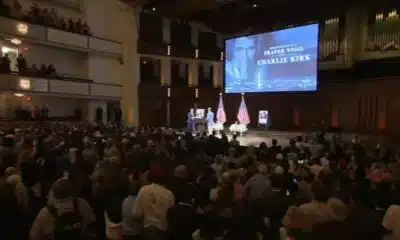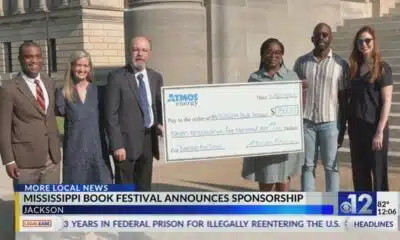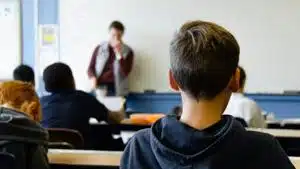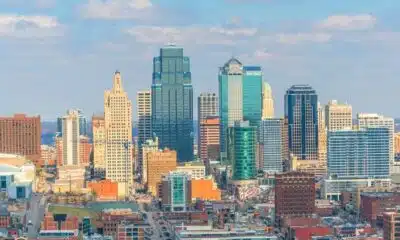News from the South - Alabama News Feed
Conservatives want to increase birth rates. These moms are terrified to have more kids. • Alabama Reflector
Conservatives want to increase birth rates. These moms are terrified to have more kids.
by Kelcie Moseley-Morris, Alabama Reflector
February 3, 2025
Clare Barkley of Ohio always pictured having a second baby. But watching the erosion of reproductive rights and fights over public education and health care, she said the world feels like it’s in upheaval and isn’t sure she wants to roll the dice.
Kristen Witkowski, a North Carolina mom of two, has had several life-threatening complications related to her pregnancies. She might have considered having a third child but is now so terrified of getting pregnant again, she said she wishes she’d had her fallopian tubes tied during her second Cesarean section.
And Brenna Craven Dumas, a mother of two in Arizona who had high-risk pregnancies, wanted to be so sure she didn’t have another, she got her tubes tied and asked her husband to get a vasectomy.
GET THE MORNING HEADLINES.
These women live in states that currently or previously had abortion bans, and cited those policies as part of or the primary reason for their fertility decisions.
The national fertility rate — calculated as the total number of live births per 1,000 women of reproductive age — has declined steadily in the United States over the past decade, from 62.5 in 2013 to 54.5 in 2023, according to the Centers for Disease Control and Prevention. The data shows the decline is present in every state to varying degrees. During the same time frame, rates have fallen steeply in states with abortion bans, including Idaho, where the rate dropped from 71.8 to 57.5, and Arizona, which fell from 66.3 to 54.1.
Those falls in fertility have been top of mind for elected politicians tied to President Donald Trump’s second-term administration. It is a central piece of Project 2025, the blueprint for Trump’s presidency as written by the conservative Heritage Foundation and several anti-abortion organizations.
In a memo issued on Jan. 29 by new U.S. Department of Transportation Secretary Sean Duffy, programs supported or assisted by transportation funds have been directed to give preference to communities with marriage and birth rates higher than the national average. As a congressman for Wisconsin, Duffy supported and co-sponsored many anti-abortion bills, including a bill to defund Planned Parenthood.
Vice President JD Vance has expressed concern over declining fertility rates for several years, and repeatedly drew attention during the 2024 presidential election for negative comments he made about women without children and society as a whole becoming too detached from the ideal of becoming a parent. He has argued that policies limiting or prohibiting abortion access, which he supports, are not contributing to the rates, and advocates for higher taxes for those who don’t have children and for expanding the child tax credit to help families.
“Our society has failed to recognize the obligation that one generation has to another is a core part of living in a society to begin with,” Vance said at the annual anti-abortion March for Life event in January. “So, let me say very simply: I want more babies in the United States of America.”
Why fertility rates are lower
Phillip Cohen, a sociology professor at the University of Maryland who specializes in population science, said birth rates have been declining for centuries as modern culture shifted away from using children as a source of labor.
“So that gets you down from eight children per woman to three or four, and then the question is, what makes you continue to go all the way down to very low numbers?” Cohen said.
In the past two decades, he attributes the decline to positive and negative factors. People have more opportunities to spend their time in other ways, especially women, along with more career and life goals that previously were more difficult or impossible to pursue. Although some women manage both a career and a family, there is often pressure to choose one for financial, societal or individual reasons.
The negative factors that are driving down rates, Cohen said, are the expenses of having children, uncertainty and risk.
“(There is) concern about being able to raise children who are competitive in an increasingly unequal world and who can succeed in a society where the penalty for not succeeding seems to be growing,” Cohen said. “If you’re worried about how your kids are going to turn out, and Americans really are … then you can increase your chances of your children succeeding by having fewer of them.”
That rings true for Katie T. in Alabama. Growing up in Alabama as one of four children, she always thought that she would have a big family — probably five kids.
But with the past few years of political developments, including Trump’s re-election, the economy and five months of being a first-time mom, she has decided one baby is enough.
She and her husband are “one and done” after their son, who was born in August. Throughout her pregnancy, Katie said she was already stressed about living in a state with a near-total abortion ban in case anything went wrong, especially as a pregnant woman close to 35, the age when pregnancies are medically considered higher risk. The closest state with broad abortion access is Virginia, which is about 10 hours away by car.
We are realizing now that daycare is a literal second mortgage payment, and we just can’t afford that.
– Katie T., Alabama resident, on not having a second child
“After I had my baby, I went in for my first checkup to talk about birth control options, and I talked with my husband at length about how I just don’t think (more kids are) in our future anymore,” said Katie T., who asked not to use her last name out of fear of retaliation in her community for her political beliefs.
Not only that, but finances also weighed heavily.
“We are realizing now that daycare is a literal second mortgage payment, and we just can’t afford that,” she said.
Not having a sibling for her son is a disappointment, she said. Her siblings are all older than her, and she describes growing up essentially as an only child, so it was important to her for a long time to have more than one child. But facing a reality of political fights over vaccines and the education system, along with more potential restrictions to reproductive health care, Katie said she had an eight-year birth control implant placed right after the election.
“I hope he will forgive us one day for that,” she said.
‘If something happens, where do we go from here?’
Kiley DeVor, 28, moved from California to Idaho to obtain a degree in physical therapy, and she specializes now in pelvic floor therapy. She and her husband bought a house, thinking they could stay in Idaho for a while, until the U.S. Supreme Court issued the Dobbs decision in June 2022 and Idaho implemented its near-total abortion ban. The state has been at the center of several abortion-related lawsuits in the past two years, including a Supreme Court case in June about whether abortions that are performed during a medical emergency are subject to prosecution under the state law. That matter is still pending in the 9th Circuit U.S. Court of Appeals.
During that time, DeVor said she’s discovered other health issues in addition to endometriosis she’s had for many years that may make conceiving a child more challenging.
“I’m just like, man, it is going to be incredibly difficult for us to get pregnant, so that’s one hurdle, and then if something happens, where do we go from there?” she said. “If we have to use IVF or IUI, if I have to travel out of state and spend another 10 or 20 grand to get the care I need, that’s just not feasible.”
DeVor’s husband started a general contracting business in Idaho that has done well, but she said he doesn’t want to risk starting a family in the state either and would rather wait until they can move somewhere she knows her health care will be protected.
“It’s been an interesting experience of moving to a state where people say, ‘We don’t want big government,’ but at the same time telling people, this is what you can and can’t do,” DeVor said.
Idaho economist doesn’t see worrying trends so far in population movement
Though one recent study from the National Bureau of Economic Research said the 13 states with total abortion bans are collectively losing 36,000 residents per quarter based on change of address data from the U.S. Postal Service, it’s unclear how many of those departures are related to politics. According to data from the American Community Survey, nearly 82,000 people moved to Idaho in 2023, while nearly 65,000 moved away, for a net increase of about 16,700 residents.
Jan Roeser, a regional economist at the Idaho Department of Labor, said the state’s population growth has slowed over the past two years, but it had accelerated greatly during the COVID pandemic between 2020 and 2022.
It’s possible that more young people are leaving the state, Roeser said, as seven districts announced or considered school closures in the first half of 2023 because of declining enrollment, according to Idaho Education News. But Idaho is among the eight youngest states in the nation, she said, and one of the leading states for job growth.
“We’d all like to be able to jump up and move just based on our beliefs, but the reality hits that most of us need a job,” Roeser said. “So really, economic opportunity is what I believe allows people to be able to make that final decision, because it’s expensive, and it’s disorienting.”
Until she starts seeing indicators like a spike in layoffs or a decline in enrollment at state universities, Roeser isn’t too concerned about outmigration. But she does worry about the steady decline of fertility rates.
“There’s not much you can do about it, of course, and it takes a long time to reverse once it starts,” she said. “It’s not something you can solve by coming up with public policy.”
Cohen said abortion bans may lead to a small increase in births initially since access is harder to reach, but in the long run, he expects it to contribute more to decreases because it creates uncertainty and fear about pregnancy.
Economically, increasing fertility rates would be a financial drain and potentially hamper growth, he said. That doesn’t mean policies that make it easier to have more children aren’t worth having, but they shouldn’t be done in the interest of increasing births.
“It’s one of the great victories of human development that we allowed people to lower their birth rates,” he said.
‘I’m not going to let them get me down’
For some people, having more children is almost an act of resistance.
Rachel West, a 34-year-old resident of central Texas, had a baby five months ago after a three-year struggle to conceive. She wants at least one more, but knows it might be a stressful experience again because of where she lives. Texas has a near-total abortion ban, along with an attorney general who has attempted to prosecute women who left the state to have an abortion. Cities in Texas have also tried to institute travel bans to prevent women from crossing state lines for abortions.
At the beginning of her pregnancy, West said there were concerns that her embryo was ectopic, when a baby grows in the fallopian tube rather than the uterus. Ectopic pregnancies are not viable and require termination to prevent infection and loss of fertility.
“We did have to think through what that would look like, if we would have to terminate, if we would have trouble finding somebody,” she said. “It was scary, we were just kind of spiraling at home trying to figure out what we would do.”
As someone who struggled to get pregnant the first time, West has also been concerned about efforts to restrict or ban IVF, just in case it becomes an option she has to utilize. But all of the news developments haven’t deterred her from the idea of having another.
“We’ve always wanted to have at least two, maybe three kids, and I would be very frustrated if because of laws in Texas, I had to change my personal life that dramatically,” West said. “It’s almost a prideful thing, where I’m like, I’m not going to let them get me down.”
YOU MAKE OUR WORK POSSIBLE.
Alabama Reflector is part of States Newsroom, a nonprofit news network supported by grants and a coalition of donors as a 501c(3) public charity. Alabama Reflector maintains editorial independence. Contact Editor Brian Lyman for questions: info@alabamareflector.com.
The post Conservatives want to increase birth rates. These moms are terrified to have more kids. • Alabama Reflector appeared first on alabamareflector.com
News from the South - Alabama News Feed
A very dry September forecast with hot afternoons ahead for Alabama.
SUMMARY: Alabama faces a very dry September with hot afternoons continuing through the last week of summer before the autumnal equinox. Sunday begins comfortably cool in the 60s, warming to low 90s by mid-afternoon under mostly sunny skies. A weak wave may bring a few showers tonight, mainly to northwest Alabama, but widespread rain is unlikely. Temperatures will remain above average, hitting mid-90s Tuesday and Wednesday. By next weekend, a trough and front may increase cloud cover and rain chances slightly, potentially lowering temperatures closer to average. Overall, the forecast calls for persistent dry and warm conditions into next week.
A very dry September forecast with hot afternoons ahead for Alabama.
WVTM13 is your home for Alabama breaking news and weather. For your latest Alabama news and weather visit: https://www.wvtm13.com/
For licensing inquiries: https://www.wvtm13.com/licensing
News from the South - Alabama News Feed
Huntsville Fire & Rescue Holds 9/11 Memorial Service | Sept. 11, 2025 | News 19 at 5 p.m.
SUMMARY: On September 11, 2025, Huntsville Fire & Rescue held a memorial service to honor the nearly 3,000 lives lost in the 9/11 terrorist attacks. Military members and first responders gathered at Huntsville Fire Station One, where at 7:46 a.m., lights, sirens, and air horns sounded to replicate the sounds heard during the attacks. Fire Chief Howard McFarland emphasized the importance of remembering the tragedy to educate younger generations and prevent history from repeating. Former Captain Lynn recalled the shock of witnessing the attacks and noted how 9/11 reshaped emergency preparedness. This annual event is held across all 20 Huntsville fire stations.
The Huntsville Fire & Rescue held a 9/11 memorial service.
News 19 is North Alabama’s News Leader! We are the CBS affiliate in North Alabama and the Tennessee Valley since November 28, 1963.
https://whnt.com/
https://www.facebook.com/whntnews19
https://www.instagram.com/whntnews19/
https://twitter.com/whnt
News from the South - Alabama News Feed
News 5 NOW at 8:00am | September 11, 2025
SUMMARY: On September 11, 2025, News 5 NOW covered 9/11 commemorations, including first responders climbing 2,000 steps at Hancock Whitney Stadium to honor the World Trade Center’s 110 stories. The Original Oyster House offered free meals to first responders in Mobile and Baldwin counties. The program also reported a new Vibrio bacterial infection case in Escambia County, highlighting health warnings for beachgoers. Additionally, they discussed a study linking chronic insomnia to increased dementia risk, election recounts in Gulf Shores, and a recent political shooting in Utah, sparking debate over harsher punishments for political violence. Viewer opinions on extraterrestrials and political violence were shared in an interactive social media segment.
First Responders in Mobile honored the heroes of September 11th, a Pensacola woman is in the hospital after being infected with the flesh eating bacteria vibrio vulnificus, and a vote re-count wrapped up in Gulf Shores…
-
News from the South - Kentucky News Feed6 days ago
Lexington man accused of carjacking, firing gun during police chase faces federal firearm charge
-
News from the South - Arkansas News Feed7 days ago
Group in lawsuit say Franklin county prison land was bought before it was inspected
-
Mississippi News Video7 days ago
2025 Mississippi Book Festival announces sponsorship
-
The Center Square6 days ago
California mother says daughter killed herself after being transitioned by school | California
-
Local News6 days ago
US stocks inch to more records as inflation slows and Oracle soars
-
News from the South - Arkansas News Feed6 days ago
Arkansas medical marijuana sales on pace for record year
-
Local News Video6 days ago
William Carey University holds 'tailgates and tourniquets' blood drive
-
News from the South - Missouri News Feed6 days ago
Local, statewide officials react to Charlie Kirk death after shooting in Utah












































